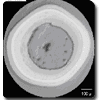Anizotropia Optyczna

Oferujemy gotowe systemy jak i komponenty
Pomiar współczynnika anizotropii optycznej

Developed in cooperation with Oak Ridge National Laboratory, a new instrument is advancing the understanding of 4th Generation nuclear fuels and reflected polarization characteristics.
The 2-MGEM Optical Anisotropy Factor Measurement System is a normal-incidence polarization reflection microscope designed to measure the sample Mueller matrix and is a 2008 R&D 100 Award Winner.
This system is designed specifically to evaluate the Optical Anisotropy Factor (OPTAF) of cross sections of TRISO nuclear fuel pyrocarbon layers. Other possible material characterizations include measuring Mueller matrix elements of other crystals, carbon compounds, and thin film coatings (e.g. surfacedeposition films) at normal incidence.
The 2-MGEM can also measure retardation (d), circular diattenuation (CD) and the polarization factor (ß). These parameters are not measurable using older techniques, since those techniques do not incorporate a compensating optical element.
Measuring TRISO:
Understanding the preferential orientation of the graphite in TRISO inner pyrocarbon (IPyC) and outer pyrocarbon (OPyC) coating layers can identify formation orientation issues that will lead to premature failure of the containment.


Advantages of measuring TRISO particles with the Hinds Instruments 2-MGEM:
No sample rotation is needed.
2-MGEM data is taken as a function of x- and y- position, making it possible to construct an image of the various measured parameters. All of the previous techniques are only able to measure at single points.
Optical resolution <4 microns
The 2-MGEM measures 8 parameters, which can then be reduced to the diattenuation N and the principal direction. The quantities N and cannot be measured simultaneously using any of the older techniques.
The 2-MGEM measures each of the 8 parameters to ~0.001; previous measurements of OPTAF were accurate to ~0.01. The 2-MGEM is 10 times more accurate. This accuracy is critical because the variations in the diattenuation from processing conditions are often as small as 0.002.
Licensed from UT-Battelle, LLC, management and operating contractor of the Oak Ridge National Laboratory, under Patent License Agreement No. 972.
Masz pytania ?
Dostawcy







